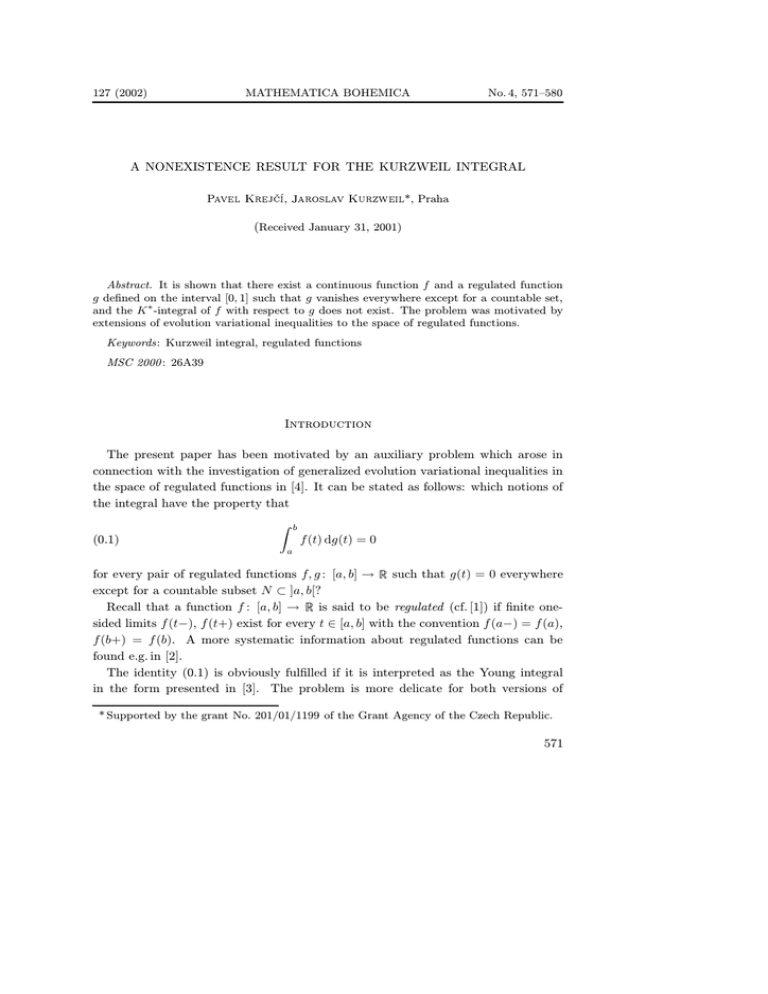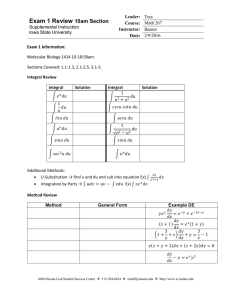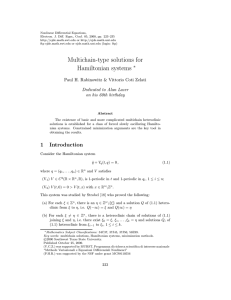Document 10524209
advertisement

127 (2002)
MATHEMATICA BOHEMICA
No. 4, 571–580
A NONEXISTENCE RESULT FOR THE KURZWEIL INTEGRAL
, *, Praha
(Received January 31, 2001)
Abstract. It is shown that there exist a continuous function f and a regulated function
g defined on the interval [0, 1] such that g vanishes everywhere except for a countable set,
and the K ∗ -integral of f with respect to g does not exist. The problem was motivated by
extensions of evolution variational inequalities to the space of regulated functions.
Keywords: Kurzweil integral, regulated functions
MSC 2000 : 26A39
Introduction
The present paper has been motivated by an auxiliary problem which arose in
connection with the investigation of generalized evolution variational inequalities in
the space of regulated functions in [4]. It can be stated as follows: which notions of
the integral have the property that
(0.1)
Z
b
f (t) dg(t) = 0
a
for every pair of regulated functions f, g : [a, b] → such that g(t) = 0 everywhere
except for a countable subset N ⊂ ]a, b[?
Recall that a function f : [a, b] → is said to be regulated (cf. [1]) if finite onesided limits f (t−), f (t+) exist for every t ∈ [a, b] with the convention f (a−) = f (a),
f (b+) = f (b). A more systematic information about regulated functions can be
found e.g. in [2].
The identity (0.1) is obviously fulfilled if it is interpreted as the Young integral
in the form presented in [3]. The problem is more delicate for both versions of
* Supported by the grant No. 201/01/1199 of the Grant Agency of the Czech Republic.
571
the Kurzweil integral, the original one introduced in [5] (the K-integral), and its
generalization proposed in [7] (the so-called K ∗ -integral). In general, the above
statement holds only conditionally, that is,
Z b
Z b
(0.2)
if
f (t) dg(t) exists, then
f (t) dg(t) = 0,
a
a
see Proposition 2.4 of [6]. On the other hand, (0.1) is true if at least one of the
functions f , g is of bounded variation, see Proposition 2.13 and Corollary 2.14 of [9].
The main result of this paper consists in giving a negative answer to the above
problem for the K ∗ -integral (and, a fortiori, for the K-integral). We construct explicitly a regulated function g : [0, 1] → which vanishes everywhere except for a
R1
countable set, and a continuous function f : [0, 1] → such that (K ∗ ) 0 f (t) dg(t)
does not exist, see Theorem 1.4 below. This means in particular that the Young
integral is not included in Kurzweil’s theory. An interested reader can find more
information about the Kurzweil integral and its relation to other types of integrals
e.g. in [6], [7], [8] or [9].
1. Statement of the main result
We first recall the definition of the Kurzweil integral. Consider a compact interval
[a, b] ⊂ . The basic concept in the whole theory is that of a δ-fine partition. We
define the set
(1.1)
Γ(a, b) := {δ : [a, b] → ; δ(t) > 0 for every t ∈ [a, b]}.
An element δ ∈ Γ(a, b) is called a gauge.
Let a = t0 < t1 < . . . < tm = b be a division of [a, b] and let τ = {τ1 , . . . , τm },
a 6 τ1 6 τ2 6 . . . 6 τm 6 b be a sequence such that τj ∈ [tj−1 , tj ] for j = 1, . . . , m.
Then the system D = {(τj , [tj−1 , tj ]) ; j = 1, . . . , m} is called a partition. For
t ∈ [a, b] and δ ∈ Γ(a, b) we denote
(1.2)
Iδ (t) := ]t − δ(t), t + δ(t)[.
Definition 1.1. Let δ ∈ Γ(a, b) be a gauge. A partition D = {(τj , [tj−1 , tj ]) ; j =
1, . . . , m} is said to be δ-fine if for every j = 1, . . . , m we have
(1.3)
τj ∈ [tj−1 , tj ] ⊂ Iδ (τj ).
If moreover a δ-fine partition D satisfies the implications
(1.3∗ )
τj = tj−1 ⇒ j = 1,
then it is called a δ-fine* partition.
572
τj = tj ⇒ j = m,
The set of all δ-fine (δ-fine*) partitions is denoted by Fδ (a, b) (Fδ∗ (a, b), respectively).
We have indeed Fδ∗ (a, b) ⊂ Fδ (a, b). The next lemma implies in particular that
these sets are nonempty for every δ ∈ Γ(a, b).
Lemma 1.2. Let δ ∈ Γ(a, b) and a dense subset Ω ⊂ ]a, b[ be given. Then there
exists D = {(τj , [tj−1 , tj ]); j = 1, . . . , m} ∈ Fδ∗ (a, b) such that tj ∈ Ω for every
j = 1, . . . , m − 1.
S
"!$#%#'&
. We have [a, b] ⊂
Iδ (t), hence there exists a finite covering
t∈[a,b]
(1.4)
[a, b] ⊂
m
[
Iδ (τj ),
a 6 τ1 6 . . . 6 τm 6 b.
j=1
The inclusion remains valid if we eliminate all intervals Iδ (τj ) for which there exists
k 6= j, Iδ (τj ) ⊂ Iδ (τk ). We claim that then we have
(1.5)
min{τj+1 , τj + δ(τj )} > max{τj , τj+1 − δ(τj+1 )}
for every j = 1, . . . , m − 1. Indeed, we obviously have τj+1 > τj , since otherwise
Iδ (τj+1 ) ⊂ Iδ (τj ) or Iδ (τj ) ⊂ Iδ (τj+1 ) according to whether δ(τj+1 ) 6 δ(τj ) or
δ(τj+1 ) > δ(τj ). Assume now that for some j we have
min{τj+1 , τj + δ(τj )} 6 max{τj , τj+1 − δ(τj+1 )}.
Then τj+1 > τj+1 −δ(τj+1 ) > τj +δ(τj ) > τj , hence the points τj +δ(τj ), τj+1 −δ(τj+1 )
do not belong to Iδ (τj )∪Iδ (τj+1 ). Then there exists necessarily either k < j such that
τj + δ(τj ) ∈ Iδ (τk ), hence Iδ (τj ) ⊂ Iδ (τk ), or k > j + 1 such that τj+1 − δ(τj+1 ) ∈
Iδ (τk ), hence Iδ (τj+1 ) ⊂ Iδ (τk ), which is a contradiction. Inequality (1.5) is thus
verified and we may choose arbitrarily
tj ∈ max{τj , τj+1 − δ(τj+1 )}, min{τj+1 , τj + δ(τj )} ∩ Ω,
t0 := a, tm := b, and the assertion immediately follows.
j = 1, . . . , m − 1,
We are now ready to give a formal definition of both types of the Kurzweil integral. For given functions f, g : [a, b] → and a partition D = {(τj , [tj−1 , tj ]) ; j =
1, . . . , m} we define the integral sum SD (f ∆g) by the formula
(1.6)
SD (f ∆g) =
m
X
f (τj )(g(tj ) − g(tj−1 )).
j=1
573
Definition 1.3. We say that J ∈ (J ∗ ∈ ) is the K-integral (K ∗ -integral,
respectively) over [a, b] of f with respect to g and denote
(1.7)
J = (K)
Z
b
f (t) dg(t),
a
J ∗ = (K ∗ )
Z
b
a
f (t) dg(t), respectively ,
if for every ε > 0 there exists δ ∈ Γ(a, b) such that for every D ∈ Fδ (a, b) (D∗ ∈
Fδ∗ (a, b), respectively) we have
(1.8)
(|J ∗ − SD∗ (f ∆g)| 6 ε, respectively).
|J − SD (f ∆g)| 6 ε,
Using the fact that the implication
(1.9)
δ 6 min{δ1 , δ2 } ⇒
(
Fδ∗ (a, b) ⊂ Fδ∗1 (a, b) ∩ Fδ∗2 (a, b),
Fδ (a, b) ⊂ Fδ1 (a, b) ∩ Fδ2 (a, b)
holds for every δ, δ1 , δ2 ∈ Γ(a, b), we easily check that the values J, J ∗ in Definition 1.3 are uniquely determined. Since Fδ∗ (a, b) ⊂ Fδ (a, b) for every gauge δ, we
Rb
Rb
also see that if (K) a f (t) dg(t) exists, then (K ∗ ) a f (t) dg(t) exists and both are
equal.
Let I be the interval [0, 1]. Consider the function Q : I → I given by the formula
(1.10)
Q(t) :=
(
2−n
if t = (2j − 1)2−n , j = 1, . . . , 2n−1 , n ∈ ( ,
0
otherwise.
The main result of this paper reads as follows.
Theorem 1.4. Let α ∈ ]0, 1[ be given and for t ∈ I put g(t) := Qα (t). Then there
R1
exists a continuous function f : I → such that the integral (K ∗ ) 0 f (t) dg(t) does
not exist.
A proof of Theorem 1.4 will be given in the next section. It makes substantial use
of the concept of outer measure µ(E) ∈ [0, ∞] of an arbitrary set E ⊂ . For the
reader’s convenience, we briefly recall here its basic properties that are used in the
sequel. By ‘meas’ we denote the Lebesgue measure in .
Proposition 1.5.
(i) For every E ⊂ we have µ(E) = inf{meas (V ) ; V open subset of , E ⊂ V }.
(ii) If E is measurable, then µ(E) = meas (E).
(iii) For every E1 ⊂ E2 ⊂ we have µ(E1 ) 6 µ(E2 ).
(iv) For every E1 , E2 ⊂ we have µ(E1 ∪ E2 ) 6 µ(E1 ) + µ(E2 ).
574
(v) Let E1 ⊂ E2 ⊂ . . . ⊂ I be a sequence of sets such that I =
∞
S
En . Then we
n=1
have lim µ(En ) = 1.
n→∞
)%*,+.-0/21
#'& -213+54 !$#%#'&
. Statements (i)–(iv) belong to the standard course on
Lebesgue measure. To prove (v), we denote mn := µ(En ) for n ∈ ( . The sequence
{mn } is nondecreasing, we can therefore put m := lim mn 6 1. Assume that
n→∞
m < 1 and put η := (1 − m)/2. By definition, for every n ∈ (
there exists an
∞
T
Vk ) are
open set Vn ⊃ En such that meas (Vn ) 6 1 − η. The sets An := I \ (
k=n
measurable, meas (An ) > η, An ∩ En = ∅ for every n ∈ ( , I ⊃ A1 ⊃ A2 ⊃ . . .. Put
∞
∞
T
S
A∞ :=
Dk ) and the
An , Dn := An \ An+1 for n ∈ ( . Then An = A∞ ∪ (
n=1
k=n
union is disjoint, hence meas (An ) = meas (A∞ ) +
∞
P
meas (Dk ). Letting n tend to
k=n
infinity we conclude that meas (A∞ ) > η, A∞ ∩ En = ∅ for every n ∈ ( , which is a
contradiction.
2. Proof of Theorem 1.4
In order to construct the function f satisfying the conditions of Theorem 1.4, we
choose a decreasing sequence {sn ; n ∈ ( } of positive numbers such that
(2.1)
σ :=
∞
X
sn <
n=1
1
.
4
We introduce the intervals
(2.2)
(
Kin := ](i − 1 + sn )2−n , (i − sn )2−n [ ,
Jin := [(i − sn )2−n , (i + sn )2−n ] ,
i = 1, . . . , 2n , n ∈ ( ,
i = 1, . . . , 2n − 1, n ∈ (
completed by J0n := [0, sn 2−n ], J2nn := [1 − sn 2−n , 1], see Fig. 1. We further denote
n
(2.3)
n
J :=
2
[
n
Jin ,
n
K :=
i=0
2
[
Kin ,
K :=
∞
\
K n.
n=1
i=1
Then J n ∪ K n = I and meas (J n ) = 2sn for every n ∈ ( , hence
(2.4)
meas (I \ K) = meas
∞
[
n=1
∞
X
Jn 6 2
sn = 2σ.
n=1
575
The function f will be constructed in the following way. We fix some h > 0 such
that
2α−1 < h < 1
(2.5)
and for n ∈ ( and t ∈ I put
n
h
fn (t) := 0
n sn + (−1)i (2n t − i)
h
2sn
(2.6)
if t ∈ Kin , i odd,
if t ∈ Kin , i even,
if t ∈ Jin , i = 0, . . . , 2n .
y
y = fn (t)
hn
0
K1n
J0n
1
4
J1n
K2n
1
2
3
4
K3n
J2n
1
t
K4n
J3n
J4n
Figure 1. Graph of the function y = fn (t) for n = 2.
Then fn are continuous, |fn |∞ = hn for every n ∈ ( , see Figure 1. We next fix an
integer r ∈ ( such that
(2.7)
hr <
1
,
2
and for t ∈ I put
(2.8)
f (t) :=
∞
X
frk (t).
k=1
The series in (2.8) is uniformly convergent, hence the definition is meaningful and f
is continuous.
R1
It remains to check that the integral (K ∗ ) 0 f (t) dg(t) does not exist. To this
end, we consider an arbitrary gauge δ ∈ Γ(0, 1), and for n ∈ ( we define the sets
(2.9)
576
En := {t ∈ I ; δ(t) > 2−n }.
By Proposition 1.5 we have lim µ(En ) = 1. We fix ν > 0 and ` ∈ (
n→∞
2σ < ν < 12 ,
(2.10)
such that
µ(E` ) > 1 − ν + 2σ.
For every n > ` we then have by (2.4) and Proposition 1.5 that
µ(En ∩ K) > µ(E` ) − meas (I \ K) > 1 − ν.
(2.11)
Let us define the sets of indices
(
Bn := {i ∈ {1, . . . , 2n } ; En ∩ K ∩ Kin 6= ∅},
(2.12)
Cn := {i ∈ {1, . . . , 2n } ; En ∩ K ∩ Kin = ∅}.
For every n ∈ (
we obviously have
En ∩ K =
(2.13)
[
(En ∩ K ∩ Kin ),
i∈Bn
hence
µ(En ∩ K) 6 (#Bn ) max{meas (Kin )} 6 2−n (#Bn ),
(2.14)
i
where the symbol ‘#’ means ‘number of elements’. This and (2.11) yields for n > `
that
#Bn > (1 − ν)2n ,
(2.15)
#Cn 6 ν2n .
We continue by introducing the sets
(2.16)
(
Xn := {j ∈ {1, . . . , 2n−1 } ; 2j − 1 ∈ Cn or 2j ∈ Cn },
Yn := {j ∈ {1, . . . , 2n−1 } ; 2j − 1 ∈ Bn and 2j ∈ Bn }.
Then #Xn + #Yn = 2n−1 , #Xn 6 #Cn , hence
(2.17)
#Yn >
1
2
− ν 2n
∀n > `.
We fix some n > ` of the form n = rp, p ∈ ( , and for every j ∈ Yrp we find
rp
rp
τ2j−1 ∈ Erp ∩ K ∩ K2j−1
, τ2j ∈ Erp ∩ K ∩ K2j
, and put t2j−1 := (2j − 1)2−rp .
The next step consists in constructing a suitable δ-fine* partition D with an arbitrarily large integral sum SD (f ∆g). We are able to control the contribution to
SD (f ∆g) on points τ2j−1 , τ2j and t2j−1 for j ∈ Yrp , while the gaps between the
577
y
h
y = frp (t)
rp
τ2jM
τ2jM −1
0 bM −1
t2jM −1
τ2jM +1 −1
aM
bM
τ2jM +1
t2jM +1 −1
aM +1 t
Figure 2. Illustration to the proof of Theorem 1.4.
points τ2j and τ2j 0 −1 for any two consecutive elements j, j 0 ∈ Yrp will be filled in by
δ-fine* partitions with zero contribution to SD (f ∆g).
Let 1 6 j1 < j2 < . . . < jN 6 2rp−1 be all elements of Yrp , N = #Yrp . We denote
a0 := 0, bN := 1, and
aM := (2jM − srp )2−rp
for M = 1, . . . , N,
bM := (2jM +1 − 2 + srp )2−rp
for M = 0, . . . , N − 1,
see Fig. 2. In each interval [aM , bM ] we use Lemma 1.2 for Ω = I \ 6 (by 6 we
M
denote the set of rational numbers) and find a partition D M = {(τiM , [tM
i−1 , ti ]) ; i =
M
1, . . . , mM } ∈ Fδ∗ (aM , bM ) such that tM
i ∈ Ω for every i = 1, . . . , mM − 1, t0 = aM ,
M
tmM = bM . We now choose arbitrarily
M
t̂M
0 ∈ Iδ (τ1 ) ∩ ]τ2jM , aM [ ∩ Ω for M = 1, . . . , N,
M
t̂M
mM ∈ Iδ (τmM ) ∩ ]bM , τ2jM +1 −1 [ ∩ Ω for M = 0, . . . , N − 1,
M
and put t̂M
i = ti otherwise. Then
(2.18)
D :=
N
[
M
{(τiM , [t̂M
i−1 , t̂i ]) ; i = 1, . . . , mM }
M =0
∪
N
[
M −1
{(τ2jM −1 , [t̂m
, t2jM −1 ]), (τ2jM , [t2jM −1 , t̂M
0 ])}
M −1
M =1
is a δ-fine* partition of I and using the fact that g(t̂M
i ) = 0 for every i = 1, . . . , mM ,
M = 0, . . . , N , we obtain
X
(2.19)
SD (f ∆g) =
g(t2j−1 )(f (τ2j−1 ) − f (τ2j )).
j∈Yrp
578
Let us now evaluate separately the three terms on the right-hand side of the
identity
(2.20) f (τ2j−1 ) − f (τ2j ) =
p−1
X
(frk (τ2j−1 ) − frk (τ2j )) + frp (τ2j−1 ) − frp (τ2j )
k=1
+
∞
X
(frk (τ2j−1 ) − frk (τ2j )).
k=p+1
By construction we have |frk (τ2j−1 ) − frk (τ2j )| 6 hrk for every k, hence
(2.21)
X
r
∞
6 hrp h ,
(f
(τ
)
−
f
(τ
))
rk
2j−1
rk
2j
1 − hr
k=p+1
and, due to the choice of τ2j−1 , τ2j (see Figure 2), we obtain that
(2.22)
frp (τ2j−1 ) − frp (τ2j ) = hrp .
rp
rp
From the inclusion K2j−1
∪ K2j
⊂ ](j − 1)21−rp , j21−rp [ it follows for k < p that
(2.23)
rp
rp K ∩ K2j−1
∪ K2j
⊂ K rk ∩ ](j − 1)21−rp , j 21−rp [
rk
⊂ K rk ∩ ](m − 1)2−rk , m 2−rk [ = Km
,
where m is the integer part of the rational number 1 + (j − 1)21−r(p−k) . Since frk is
rk
constant on Km
, we obtain from (2.23) that
(2.24)
frk (τ2j−1 ) − frk (τ2j ) = 0 for k < p.
Combining (2.20) with (2.21), (2.22) and (2.24) yields
(2.25)
f (τ2j−1 ) − f (τ2j ) > hrp
1 − 2hr
1 − hr
for every j ∈ Yrp . We moreover have g(t2j−1 ) > 2−αrp for every j ∈ Yrp , and from
(2.17), (2.19) we conclude that
(2.26)
SD (f ∆g) > (#Yrp )(2−α h)rp
1 − 2hr
1 − 2hr
1−α rp 1
>
(2
h)
−
ν
.
1 − hr
2
1 − hr
Since p can be chosen arbitrarily large and 21−α h > 1, we see that (K ∗ )
does not exist and Theorem 1.4 is proved.
R1
0
f (t) dg(t)
579
References
[1] G. Aumann: Reelle Funktionen. Springer, Berlin, 1954. (In German.)
[2] D. Fraňková: Regulated functions. Math. Bohem. 119 (1991), 20–59.
[3] T. H. Hildebrandt: Introduction to the theory of integration. Academic Press, New York,
1963.
[4] P. Krejčí, Ph. Laurençot: Generalized variational inequalities. J. Convex Anal. 9 (2002),
159–183.
[5] J. Kurzweil: Generalized ordinary differential equations and continuous dependence on
a parameter. Czechoslovak Math. J. 7 (1957), 418–449.
[6] Š. Schwabik: On the relation between Young’s and Kurzweil’s concept of Stieltjes integral. Časopis Pěst. Mat. 98 (1973), 237–251.
[7] Š. Schwabik: On a modified sum integral of Stieltjes type. Časopis Pěst. Mat. 98 (1973),
274–277.
[8] Š. Schwabik, M. Tvrdý, O. Vejvoda: Differential and Integral Equations: Boundary Value
Problems and Adjoints. Academia and D. Reidel, Praha, 1979.
[9] M. Tvrdý: Regulated functions and the Perron-Stieltjes integral. Časopis Pěst. Mat. 114
(1989), 187–209.
Authors’ addresses: Pavel Krejčí, Jaroslav Kurzweil, Mathematical Institute, Academy
of Sciences of the Czech Republic, Žitná 25, 115 67 Praha 1, Czech Republic, e-mail: krejci
@math.cas.cz, kurzweil@math.cas.cz.
580





